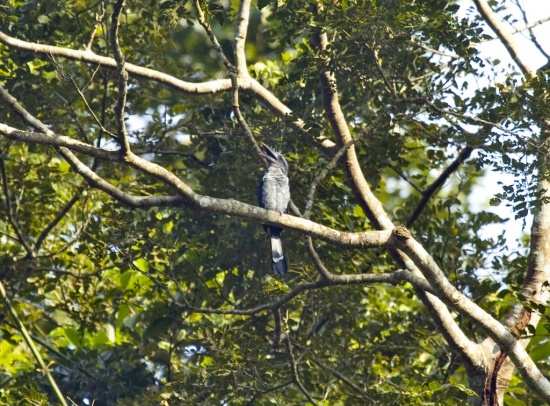Alternative name: Dwarf Black Hornbill
- Horizocerus hartlaubi
Identification
32cm. A small, blackish hornbill.
- Mostly black plumage
- Broad white eyestripe
- Black tail with white tip
- Dark bill with red tip, dark casque (red casque in granti)
- Blackish bare skin around eye
- Flesh-coloured throat skin
Females are smaller than males, the bill is all dark and the casque smaller.
Juveniles are similar to females.
Distribution
Found in tropical Africa from southern Sierra Leone and southern Guinea east to Cameroon, Democratic Republic of Congo east to South Sudan and western Uganda, south to northwest Angola.
Locally common.
Taxonomy
Formerly placed in the genus Tockus.
Subspecies[1]
There are 2 subspecies:
- H. h. hartlaubi:
- Sierra Leone to Zaire (west of Congo River)
- H. h. granti:
- Congo basin of Central African Republic to Zaire and Uganda
Habitat
Tall evergreen and gallery forest.
Behaviour
Feeds mainly on insects, takes also spiders, small lizards and rarely fruit.
Feeds mainly in the subcanopy, sometimes following monkeys to take insects disturbed by them.
Little known about breeding. Nests in a natural cavity in a tree, the female seals herself in. Lays probably up to 4 eggs.
References
- Clements, J. F., T. S. Schulenberg, M. J. Iliff, D. Roberson, T. A. Fredericks, B. L. Sullivan, and C. L. Wood. 2015. The eBird/Clements checklist of birds of the world: v2015, with updates to August 2015. Downloaded from http://www.birds.cornell.edu/clementschecklist/download/
- Del Hoyo, J, A Elliot, and J Sargatal, eds. 2001. Handbook of the Birds of the World. Volume 6: Mousebirds to Hornbills. Barcelona: Lynx Edicions. ISBN 978-8487334306
- Avibase
Recommended Citation
- BirdForum Opus contributors. (2025) Western Dwarf Hornbill. In: BirdForum, the forum for wild birds and birding. Retrieved 15 January 2025 from https://www.birdforum.net/opus/Western_Dwarf_Hornbill
External Links
GSearch checked for 2020 platform.




